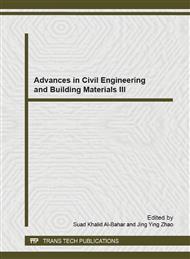p.36
p.40
p.44
p.49
p.53
p.58
p.62
p.67
p.73
Investigations of Vibration Based Condition Assessment of Timber Beams Strengthened with Fiber Reinforced Polymer
Abstract:
In recent years, research trend on structural condition assessments have largely shifted toward utilizing vibration based methods for structural damage detection and evaluation. On the other hand, research and applications on use of fiber reinforce polymer (FRP) on timber for strengthening or repair damaged timber members in various types of timber structures has also become increasingly popular. Although the application of FRP for repair and/or strengthening of structures has been researched for a long time, research on non-destructive assessment or evaluation of the effectiveness and reliability after FRP repairing or strengthening is yet to be carried out. In this paper, the authors made an attempt on investigation of such issue utilizing Damage Index method, which is a robust vibration-based approach for damage detection. The investigation was aiming at localizing and quantifying damage in timber beams and, more importantly evaluating the effectiveness after the damage was repaired. An experimental program was carried out on five laminated veneer lumber (LVL) beams. Various damage scenarios (i.e. severe, medium, light damage) are introduced on these beams and then repaired with carbon fiber reinforced polymer (CFRP). Experimental results indicate that the use of CFRP was effective in repairing the damaged timber beams. Utilizing Damage Index method can accurately detect the damage location. However, the investigation also shows that direct application of the Damage Index for evaluation of the effectiveness of rehabilitation of the damaged timber beam is not satisfactory. Further investigation and modification of the Damage Index method will be carried out in next stage research.
Info:
Periodical:
Pages:
53-57
Citation:
Online since:
December 2013
Authors:
Price:
Сopyright:
© 2014 Trans Tech Publications Ltd. All Rights Reserved
Share:
Citation:


